Our last morning in our little apartment began with scrambled eggs with cheese and toast – just because we had to eat the last of our provisions. We washed up the dishes and packed the car. We were set to go by 8:30 and leaving Meadow Lake by 8:45 after my driver got his morning coffee. But, first . . . a warning light was telling us that tire pressure was low. Thankfully, we were still in town and pulled into a station to put some air in the tires. After a bit of fumbling around, we realized the air hose wasn’t working properly. Off to another station farther down the road. Their air hose worked just fine and the tires were happy again; the light went off and we went on.
On our way to Havre, MT, our destination for today, we took Highway 2 all the way, noticing how the landscape went from mountains to rolling hills before flattening for grazing or agriculture that supported livestock. There were lots of fields with hay bales as we moved East through the area. But, the land is very dry here, too, and we could still see clouds of fire smoke hanging over everything.
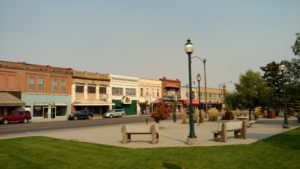 Arriving in Havre by about 2:00 we promptly found a place for lunner (that’s lunch and dinner). Deciding where to eat on the road is always an exercise in discernment . . . and then trusting that what we do find is actually what we really wanted. We set out for a place called Duckie’s Cafe and ended up at Wolfer’s instead because we’d missed a turn and were trying to backtrack. However, Wolfer’s was between here and there and it looked inviting. It was a tiny diner right out of the 1950’s with a menu to match. We ate and were more than satisfied, taking half of our plates with us to finish later.
Arriving in Havre by about 2:00 we promptly found a place for lunner (that’s lunch and dinner). Deciding where to eat on the road is always an exercise in discernment . . . and then trusting that what we do find is actually what we really wanted. We set out for a place called Duckie’s Cafe and ended up at Wolfer’s instead because we’d missed a turn and were trying to backtrack. However, Wolfer’s was between here and there and it looked inviting. It was a tiny diner right out of the 1950’s with a menu to match. We ate and were more than satisfied, taking half of our plates with us to finish later.
Next stop, the nearby town of Chinook and the Blaine County Museum. This museum also covers as a National Park site for the Bear Paw Battlefield where the Nez Perce Indians were forced to surrender their lands to U.S. troops after a four month battle in September of 1877. It was the last battle of the Indian Wars. It’s always so sobering to learn the details of some of the injustices that our country has inflicted on others. But, it is a necessary learning. If we are not aware, we are destined to repeat our mistakes instead of learning how to work to overcome them the next time.
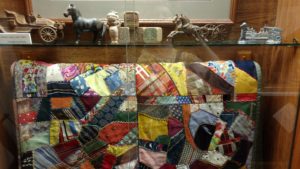 As we have found so many times, some of the little county museums are amazingly detailed. Only this one was not little at all. It was two full floors packed with Montana history from the earliest days of settlers in the area. One of the most fascinating displays for me was a photo collection of locals who had sat for the town photographer in the late 1800’s to early 1900’s. The collection is extensive, as the family of the photographer donated all his work to the museum.
As we have found so many times, some of the little county museums are amazingly detailed. Only this one was not little at all. It was two full floors packed with Montana history from the earliest days of settlers in the area. One of the most fascinating displays for me was a photo collection of locals who had sat for the town photographer in the late 1800’s to early 1900’s. The collection is extensive, as the family of the photographer donated all his work to the museum.  The selected subjects that were displayed were engaging and haunting. One of the most touching for me was a photo of an Hispanic man, a migrant worker who came to these parts to work in the sugar beet fields. In the portrait he is wearing suit and tie and hat, with a small picture of his wife and three daughters tucked in his jacket pocket. It was probably the only way he could have a family photo.
The selected subjects that were displayed were engaging and haunting. One of the most touching for me was a photo of an Hispanic man, a migrant worker who came to these parts to work in the sugar beet fields. In the portrait he is wearing suit and tie and hat, with a small picture of his wife and three daughters tucked in his jacket pocket. It was probably the only way he could have a family photo.
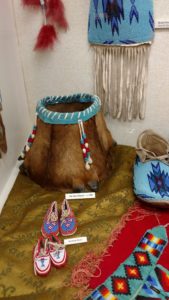 There were also rooms and rooms of beautiful Native American hand crafts; settler quilts and lace; as well as tools and implements for both home and farm.
There were also rooms and rooms of beautiful Native American hand crafts; settler quilts and lace; as well as tools and implements for both home and farm.
There were two objects that I could not help capture in a photo. I could hardly imagine what use they once had! See if you can figure out. The answers will be posted tomorrow.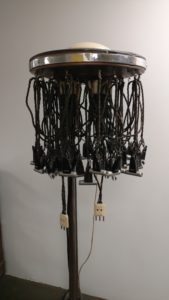
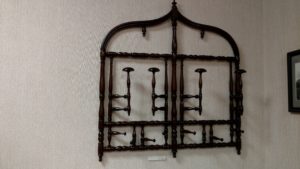
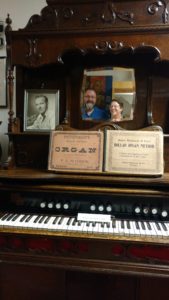 We stayed until the museum closed and Randy helped the curator take down her flag signaling she was going home. It was an informative and educational afternoon. Since all the signage that was once at the Bear Paw Battlefield was now located in the museum, we elected to skip driving the extra hour to stand on the actual site.
We stayed until the museum closed and Randy helped the curator take down her flag signaling she was going home. It was an informative and educational afternoon. Since all the signage that was once at the Bear Paw Battlefield was now located in the museum, we elected to skip driving the extra hour to stand on the actual site.
Instead, we found our way to the motel and packed in for the night. I took a two mile walk along Highway 2 (there was a wide sidewalk through town) and then we settled in to rest up for tomorrow’s adventures.